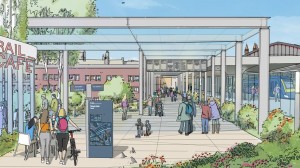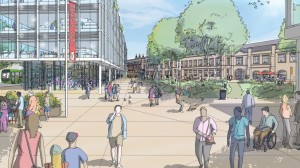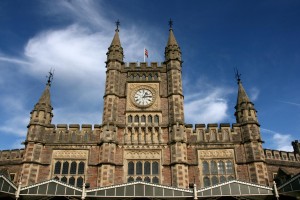Building work on a much-needed new entrance to Bristol Temple Meads station, the first of three, has begun – but it will not be open to the public for three years.
The new entrance, to the historic station’s east, will link directly to the University of Bristol’s new Enterprise Campus on the former sorting office site off Cattle Market Road, which is now under construction.
While full building work on the new entrance will begin early next year and is expected to take 13 months, the finished building will be shrouded until September 2026 to allow for the completion of the new university campus and adjoining public space.
The initial work now underway does, however, signal the start of the long-delayed regeneration of the wider area.
It will also open up the station to the east of the city, the former industrial heartland that will be transformed over the next decades through a massive redevelopment project.
The new entrance is funded by the £94.7m secured last year from central government for the Temple Quarter programme by Metro Mayor Dan Norris, who heads the West of England Combined Authority.
It is the first major piece of infrastructure delivery under the regeneration programme, which is being administered by WECA and will include new homes, jobs and public spaces.
Under the Temple Quarter regeneration programme, a partnership project between WECA, Bristol City Council, Homes England and Network Rail, which owns the station, 130 hectares of brownfield land will be regenerated to include 10,000 new homes along with new business areas.
With its original passenger shed and engine shed designed and built by Brunel in 1840, Grade I listed Temple Meads is one of the oldest surviving railway terminus buildings in the world.
However, it is also one of the last remaining unimproved mainline train stations in the UK.
Network Rail announced a ‘vision’ for the station to much fanfare 11 years ago, saying it would transform it into a ‘world-class railway hub’.
The scheme, which also included opening up the east side of the station as well as bringing two unused platforms back into use, was later abandoned after the funding was withdrawn.
During that period, Birmingham’s New Street station was transformed with a £750m facelift.
Temple Meads currently handles around 10m passengers a year – a figure expected to rise to more than 22m by 2030, meaning much greater capacity, improved access and better facilities will be needed in the long term.
Initial works to prepare for the construction of the new east entrance were carried out three years ago using £22m from WECA to keep the programme on track before the higher government grant was secured.
Mayor Norris, pictured, said by taking this proactive partnership approach, the Temple Quarter partners were able to save time and money as well as reducing disruption to rail passengers.
Over the coming months, work will include piling to support the new entrance in the existing retaining wall, followed by breaking through the wall and excavation works to create a tunnel linking to the existing passenger subway inside the station.
Mayor Norris said: “I’m thrilled that works to create a brand-new entrance at Brunel’s iconic station to improve access for locals east of the city are now underway, all part of one of the most exciting regeneration projects in Europe which I’m proud is being administered by my West of England Mayoral Combined Authority.
“Combine this with my multi-million-pound programme of region-wide rail improvements, including the opening of Portway Park and Ride in the summer, and soon-to-be new stations at Ashley Down and elsewhere, and it’s clear we’re making getting from A to B in the West easier, safer and more pleasant than ever before.
“It’s another important step on the journey to regenerate this amazing city and have, at long last, the jewel in the crown in the heart of our great West of England region.”






























